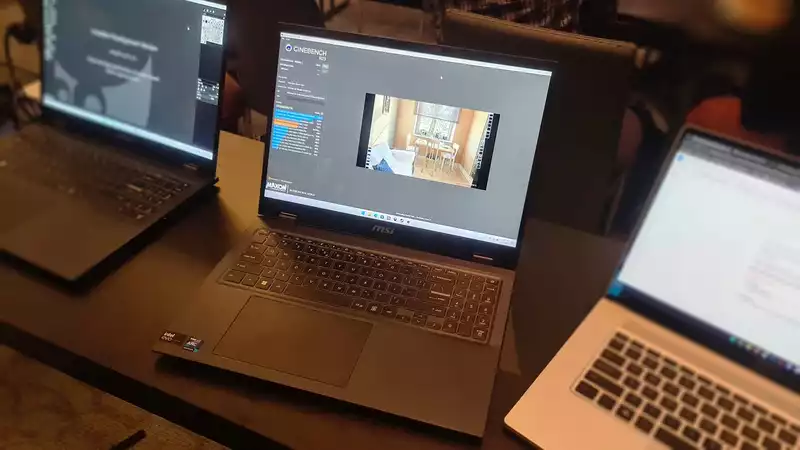At CES 2024, I was allowed to use the MSI Prestige 16 laptop for a few hours as I pleased. On the surface, this may not sound very exciting to PC gamers, since the Prestige line is not explicitly built for gaming, but the laptop was powered by Intel's latest Core Ultra 165H processor. It is a 55W version of Meteor Lake, with six P-cores, eight E-cores, two Low Power E-cores, and eight Xe-cores, quite a lot for a small mobile chip.
Give me some time with the new chip and I will get to grips with the games I play on it. Let's start with the best gaming performance I've experienced. While I was installing another game on my machine, a fellow journalist let me play Shadow of the Tomb Raider on their machine. My first impression was that it was very good for a mobile iGPU.
At SotTR's lowest graphics settings, with XeSS set to balanced, we saw an average of 71 fps at 1080p and a minimum of 60 fps. This may sound like child's play for a discrete GPU, but I have been using a NUC 15 laptop with a Tiger Lake generation mobile processor for several years and am writing this, and it is not a pleasant experience for gaming. By comparison, the Core Ultra 7 165H performed quite well on SotTR.
We can tweak the settings a bit more for better graphics quality: with XeSS turned up to Performance mode and the game set to Medium, we get an average of 56 fps and a minimum of 43 fps.
We ran several other benchmarks covering various combinations. Here are the results:
On the flip side, when adventuring without XeSS, you need to lower your expectations: on SotTR, we stayed at a minimum of 30 fps with XeSS disabled. I also ran Horizon Zero Dawn on my machine at 1080p with the medium preset and it only reached 38 fps on average, with a 1% minimum of 30. This is not the full picture either, as it ignores the fairly obvious hangs that occurred at various points during the benchmark run.
Playing games with just the iGPU was not at all pleasant.
The key is XeSS or some kind of upscaling (FSR, which AMD widely supports, is sufficient). This was evident from my first gaming experience on Meteor Lake late last year, and my further experimentation with Arc GPU tiles has only strengthened my conviction.
Still, if you are looking at this not as a replacement for a gaming laptop, but as an addition to a laptop you might use for work or school, that is where I think it has the potential to shine. Personally, my work laptop (not a gaming laptop), which I stretch out just to play Crusader Kings 3, is pretty bad at it; I don't think the 165H would have as much trouble.
Here are some other benchmark numbers I ran on the Meteor Lake machine:
As you can see, this chip got pretty hot. It also consumed a bit more power than the PL1 limit, which is the nature of Intel's PL1/PL2 limit in mobile. It jumps above PL1 for a period of time. This may not be as much of an issue in more rugged notebooks that can handle this chip, but in more compact notebooks, the power limit needs to be reduced to keep up with the heat. Intel calls the former "max performance" and the latter "max portability. The Asus Zenbook 14 here is powered by an Ultra Core 7 155H, but only runs at a base power value of 28 W. Given that it is much slimmer than the MSI, we will be testing how well this thin and light machine can handle gaming in the coming weeks.
What is important for both MSI and Asus is the amount of memory available to the iGPU. iGPUs share a memory pool with the entire system, so the more RAM available, the better. Both machines have 32 GB on board, and anything less than that could start to affect performance. Intel has made 16GB a minimum requirement for manufacturers who put Arc graphics badges on their laptops.
In the configurations I have experimented with at MSI, I think Meteor Lake will deliver practical gaming performance. Sacrifices have to be made for this kind of iGPU, to be sure, but as we are seeing in the growing gaming handheld market, it can be acceptable for on-the-go gaming. Indeed, even an office notebook with a Core Ultra chip can achieve adequate frame rates. Likewise, along with the discrete GPU, there is the flexibility of being able to save battery power and run on the iGPU as long as the game allows.
Battery life figures will need to be reported again, as we did not have enough hands-on time.
The key battle for Intel will be against AMD's current 7040 series and future 8040 series chips; according to Time Spy Extreme benchmark numbers, Intel seems to have the lead in GPU performance over the Ryzen 9 7940HS. I am referring to the older numbers from the Razer Blade 14 review (GPU score: 1,152) and the latest numbers from the latest Framework 13 (GPU score: 1,164), both with AMD's top 780M integrated graphics silicon.
Hopefully Intel's drivers will be able to take advantage of AMD's possible gaming performance lead, if any.
.

Comments